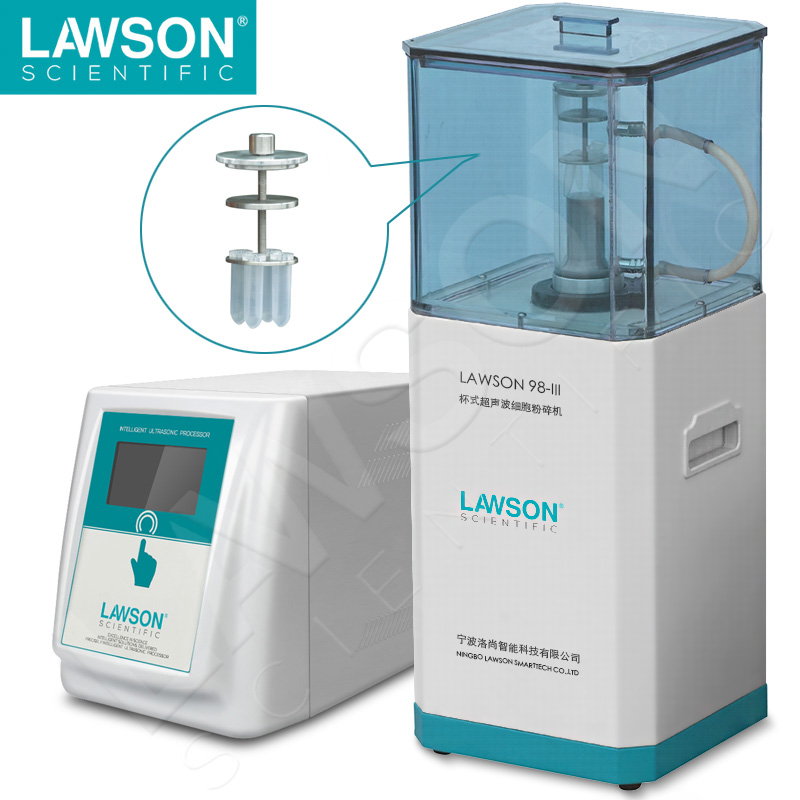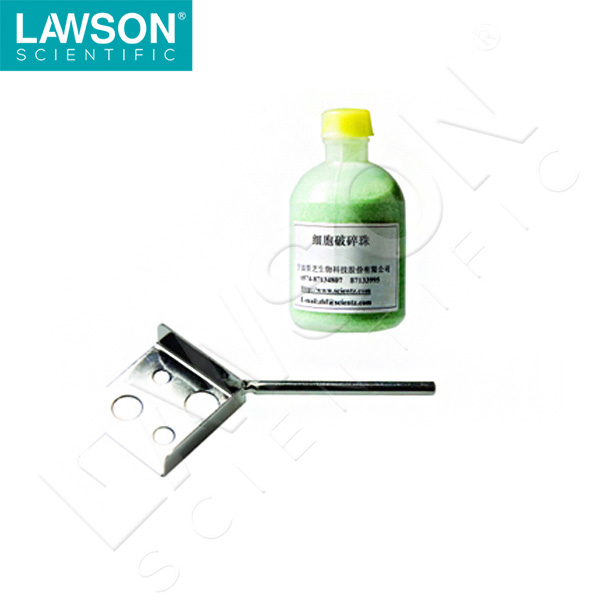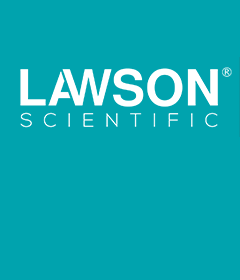Non-contact ultra processor



non-contact ultrasonic Lawson08-II is used for aseptic breakage, which can break chromosomes and break cells through the centrifuge tube. With silencing and pressing device, DL-1510 type low temperature coolant circulation machine is optional.
 Contact
Contact
 Online Consult
Online Consult
- Description
- Specifications
- Paper
- Video

non-contact ultrasonic Lawson08-II is used for aseptic breakage, which can break chromosomes and break cells through the centrifuge tube. With silencing and pressing device, DL-1510 type low temperature coolant circulation machine is optional.
Lawson08-II non-contact ultrasonic crusher, also called cup crusher, is used for aseptic crushing. It can break chromosomes and break cells through the centrifuge tube. It is specially tailored for the pretreatment of next-generation sequencing DNA samples and chromatin immunoprecipitation experiments. Compared with the traditional probe-contact ultrasonic cell crusher, non-contact samples can be crushed in a sealed container without causing infectivity. Flying fog, the ultrasonic probe does not contact the sample to avoid cross-contamination. Non-contact ultrasonic pulverizers can achieve unparalleled quality, efficiency and safety of traditional ultrasonic methods.
Multiple samples can be detected at one time, with high experimental efficiency; no wear and slag removal, each sample is in a separate fully enclosed test tube to avoid cross-contamination; optional cooling water circulation system, which is convenient for samples to be ultrasonicated in a 4 ℃ water bath, energy The distribution is uniform and the ultrasonic effect is complete; the ultrasonic parameter setting is flexible, the experimental steps are standardized, the experiment repeatability is good, and the results are highly reliable.
It has gradually become an indispensable standardized tool for ChIP (chromatin immunoprecipitation) and DNA shearing research platforms. It has high experimental efficiency, reliable results, and good repeatability. It can process a minimum of 5ul samples and is suitable for precious samples.

⒈ No aerosol aerosol production - enhanced biological safety (such as mycobacteria, viruses, etc.)
⒉ Eliminates the risk of cross-contamination of samples
⒊ Eliminate the traditional probe wear and slag phenomenon
⒋Can handle a variety of samples, a wide range of sample processing
⒌Suitable for various standard containers
⒍Can be used to process micro samples, minimum to 5ul
⒎The automatic continuous rotation of the centrifuge tube makes the energy distribution of the ultrasonic wave more uniform
⒏The high and low temperature constant temperature water bath can be selected, and the Eppendorf tube crushing rotating base of various diameters can be customized according to customer needs

| Model | Lawson08-II |
| Frequency | 19.5-20.5KHz |
| Power | 3200W |
| Power Adjustment Range | 450--3200W continuously adjustable |
| Time Control Accuracy | ±1% can be set arbitrarily |
| Work times setting | ±1% can be set arbitrarily |
| Ultrasonic time setting | 1-99 times, digital display |
| Gap time setting | 1-99 times, digital display |
| horn end diameter | Φ30 |
| Crushing capacity | (0.1-2ml)×16 |
| Duty Cycle | 1-99% |
| Power | 220/110V 50Hz/60Hz |
| Working environment | 0--32℃, RH80, 760±30mmHg |
| Transducer Assembly Approx. | 18kg |
| Transducer Weight | 24kg |
| Generator Size | 140×330×210mm |

| Ultrasonic Processors | 1 stand |
| Vibration system (transducer assembly) | 1 single |
| tube | 16 root |
| power cable | 1 root |
| fuse | 4 single |
| user's manual | 1 part |
| certificate | 1 part |
| Warranty Card | 1 part |




PDF:Ultrasonic Cannabis Extraction
PDF:Cavitation Erosion Testing (ASTM G32-92)
PDF:Ultrasonic Micro-Encapsulation
PDF:Ultrasonic Fractionation of Cells in Microplates
PDF:Cavitation Erosion of Ultrasonic Probes
PDF:Ultrasonic Transesterification of Oil to Biodiesel
PDF:Cell Disruption
Methods of cell disruption:
1. Mechanical crushing method: refers to the use of a masher, a grinder or a homogenizer to break the cells apart.
1. High-speed tissue mashing: make the material into a thin paste liquid, place it in about 1/3 of the volume of the cylinder, close the cylinder lid tightly, turn the governor to the slowest position first, turn on the switch, and gradually accelerate to the desired position. speed required. This method is suitable for animal visceral tissue, plant succulent seeds, etc.
2. Homogenization by glass homogenizer: first place the chopped tissue in a tube, then insert the grinding rod into the tube to grind it back and forth, and move it up and down to grind the cells. High, suitable for small amount and animal organ tissue.
2. Physical fragmentation method: refers to the use of temperature difference, pressure difference or ultrasonic wave to break cells apart.
1: Treat the cell suspension with a certain power of ultrasonic wave, so that the cells are violently shaken and broken (the cell wall and organelles are broken by the vibration force of the ultrasonic wave).
Mechanism: It may be related to the cavitation phenomenon of bubble generation, growth and fragmentation when strong sonic waves act on the solution, and the shock wave and scissor force caused by the cavitation phenomenon cause cell lysis.
The efficiency of sonication depends on the sound frequency, sound energy, treatment time, cell concentration and cell type, etc. (Pay attention to cooling down when using to prevent overheating).
2. High-pressure fragmentation: The cell suspension is ejected from the annular gap of the high-pressure chamber onto the stationary impact ring, and is forced to change direction and flow out through the outlet tube. During this process, the cells undergo high-speed shear collisions and changes from high pressure to atmospheric pressure, thereby breaking up and releasing the contents.
This is an ideal method for gentle, thorough cell disruption.
3. Repeated freeze-thaw method: freeze the cells below -20 degrees, thaw at room temperature, and repeat several times. Due to the formation of ice particles in the cells and the increase of the salt concentration of the remaining cell fluid, the swelling will be caused, and the cell structure will be broken.
3. Chemical fragmentation method: refers to the use of formaldehyde, acetone and other organic solvents or surfactants to act on the cell membrane, so that the structure of the cell membrane is damaged or the permeability is changed.
Some animal cells, such as tumor cells, can be destroyed by the use of sodium dodecyl sulfonate (SDS), sodium deoxycholate and other cell membranes. The concentration is generally 1 mg/ml.
4. Enzymatic fragmentation method: Use appropriate enzymes to destroy the cell wall, and then fragment the protoplasts in a hypotonic solution.
Bacterial cell walls are thicker and can be treated with lysozyme for better results.
Standard formulation of lysate: : 50mM Tris-HCl (pH8.5~9.0), 2mM EDTA, 100mM NaCl, 0.5% Triton X-100, 1mg/ml lysozyme. (Lysozyme works better in this pH range).
Comprehensive description: No matter which method is used to disrupt tissue cells, intracellular proteins or nucleic acid hydrolase will be released into the solution, which will biodegrade macromolecules, resulting in a reduction in the amount of natural substances. Adding diisopropyl fluorophosphoric acid (DFP) Can inhibit or slow down autolysis; the addition of iodoacetic acid can inhibit the activity of those proteolytic enzymes that require a sulfhydryl group in the active center, and the addition of phenylmethanesulfonyl fluoride (PMSF) can also eliminate the activity of proteolytic enzymes, but not all, And it should be added several times while crushing; in addition, pH, temperature or ionic strength can also be selected to make these conditions suitable for the extraction of the target substance.

Precautions before use:
1. Select an appropriate probe according to the volume of the sample to be processed. Before and after use, the probe must be wiped with an alcohol cotton ball, and the probe must be replaced with a special wrench;
2. When the AMPLITUDE knob is turned on, the probe must not be exposed to the air, and in special cases (test probe) should not exceed 10 seconds;
3. Prepare an ice box before use, and the sample must be placed in an ice bath during processing, and the sample concentration should not be too large.




